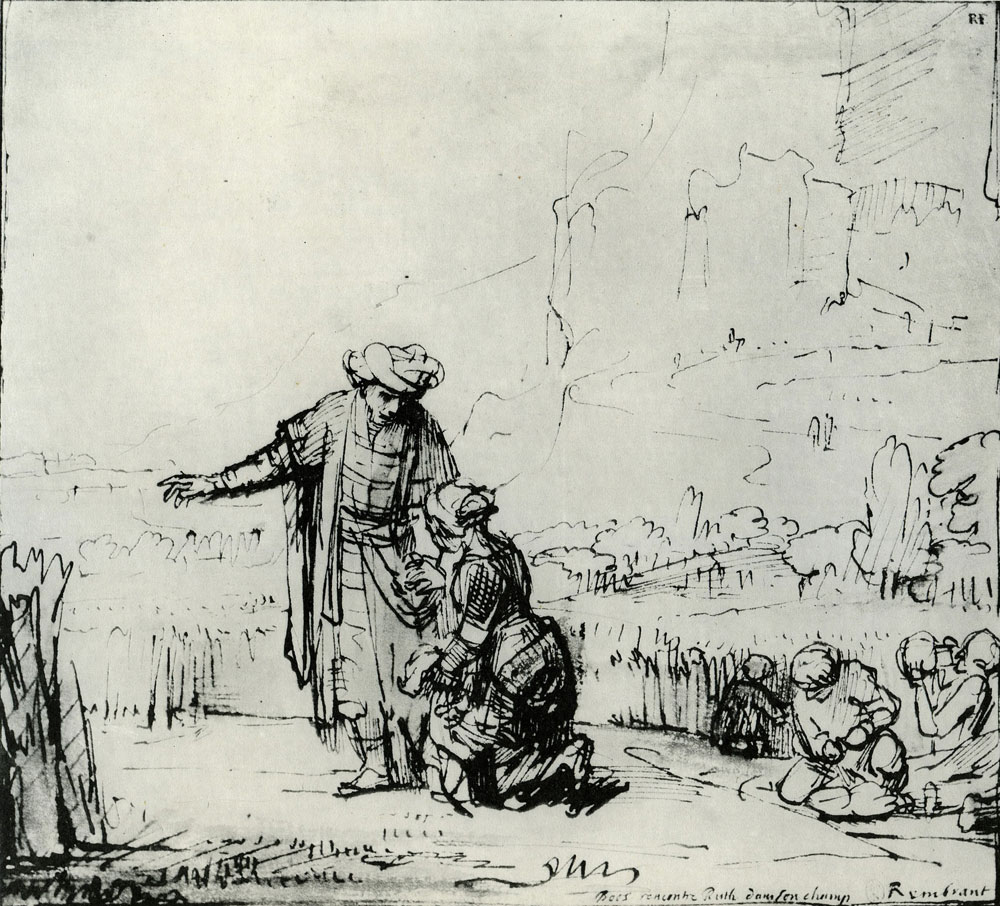“Spread the skirt of your cloak over me”
“Take the cloak you are wearing and hold it out”
She came up behind him and touched his cloak.
“His banner over me was love”
Same cloak? It would've been cool if the cloak Boaz filled with grain for Ruth to take home to her mother-in-law was the same cloak he had spread over her. It does seem that in both cases he is offering her exceptional protection and providing. His cognizance of her, his concern for her, has gradually raised her in his eyes. And he responds generously and thoughtfully. This developing relationship between them grows from respect and dignity, grace and gratitude, to trust and a warmer current. I don’t know if we can fit it into modern romantic-love plot lines, but we can see for certain an arrival on common ground. Ruth is no longer dependent, in the same way as she was before; she has come into her own. She who referred to herself as servant is called by Boaz daughter, and warmer terms await. It is a shift of status much like that of Jesus’ followers of whom he said, ‘I do not call you servants any longer, …but I have called you friends.’ (John 15:15) Before we rush on to the happy ending it is well to pause the movie a moment and reflect on the cloaking device. “Spread the skirt of your cloak over me” says Ruth, bring me under your protection, and act as my redeeming kinsman. The garment is a symbol of the gesture that is much larger: bringing under protection, as under the wings.
I am reminded of a song we sang at a coffeehouse gathering in high school, with the refrain “his banner over me is love” - it is from the Song of Songs, the Song of Solomon. It is a bride’s song of her beloved, so it will fit well with the fate of our once-lonely once-stranger; but it is more; it is a symbol and manifestation of coming under the protection, as under the shadow of the wings, of God. There will be found shelter, there will be found mercy, there will be found protection, there will be found - home.
The whole point of Ruth’s journey for us may be that we too may find ourselves bereft, widowed or orphaned, and in need of a new home. We may discover in the depths of loss a newfound dignity in continuing to care for another, and eventually to receive care. Dignity and respect are restored; the story of Ruth is a story of restoration, in the sense of coming home to a place she has never known. In his Christmas oratorio, in a passage that has been worked into a hymn, W. H. Auden foretells, “You shall come to a place you have never been before and they shall welcome you home.”
“He is the Way.
Follow Him through the Land of Unlikeness;
You will see rare beasts, and have unique adventures.
He is the Truth.
Seek Him in the Kingdom of Anxiety;
You will come to a great city that has expected your return for years.
He is the Life.
Love Him in the World of the Flesh;
And at your marriage all its occasions shall dance for joy.”
― W.H. Auden, For the Time Being: A Christmas Oratorio
Like the weary travelers in our tale, who have traveled through an unlikely land, from Moab to Bethlehem, at a time of deep anxiety, we can find a new life, a new home, as we are received into the family of the people of God, a family like no other, one that welcomes us without kinship ties but with kindness, that recognizes in steadfast loyalty and kindness a true affinity deeper than blood relations.
The seeking of protection, of healing and wholeness, of restoration to a place in common life, in community, is what the woman with hemorrhages seeks from Jesus. He is never just about physical healing, even when that is what is sought and given; there is a healing of the whole person, and a wholeness of community, that comes from his actions. His acts are both practical compassion and symbolic manifestation. Something is going on here: the coming of the kingdom of God.
The kingdom of God, which turns out to be much more than the kingdom of one nation, is known to us through the truth, character, compassion, dignity, wisdom, and piety of its people.* As we grow into those gifts we grow into his kingdom.
The takeaway for Ruth in chapter 3 was more than the grain she could carry in the cloak she had borrowed; and the takeaway for us is more than romantic expectations. She found under the shadow of the wings of the Lord, and in the care of a near kinsman, provision and care. We find, as we place ourselves within the circle of the covenant of God with humankind, that we are now explicitly part of something greater than human community: we are part of a kingdom of loyalty and steadfast caring that is exhibited most fully in the person of the one whose garment the lady with the hemorrhage touched, the embodied love of God that is Jesus.
Suzanne Guthrie: “I love the profound simplicity of this catacomb fresco. Here is the image as it appears in the woman’s memory: no pressing crowd to obscure her, surrounded by silence, the background washed away by insignificance, she reaches forth to touch and knows immediately that she’s healed. Here is a picture of the inside of prayer - intimacy magnified.”
http://edgeofenclosure.org/proper8b.html





